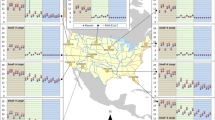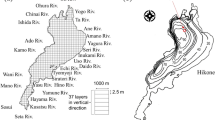Abstract
We applied a three-dimensional lake water quality model to investigate the influence of local meteorological conditions on fish habitat under one historical and two future climate change scenarios. Compared to the historical normal climate scenario, the averaged surface water temperature increases up to 4 °C and the dissolved oxygen concentration is 1 mgL−1 less during the ice-free seasons under the future climate scenarios. The stratification periods expand up to 23% (46 days), thermocline depths increase 49%, and the onset of anoxia occurs 4 weeks earlier under the future climate scenarios. The dissolved oxygen concentrations and water temperatures are used as the key water quality parameters to investigate the temporal and spatial variabilities of fish habitat. The good growth, restricted growth, and lethal habitats for the coolwater fish change up to 14% of the total lake volume. Compared to the historical normal climate scenario, on average, the lake total volume for good growth, restricted growth, and lethal habitat of coolwater fish change +16, −18, and +85%, respectively. The most significant (70%) changes in lethal habitat for coolwater fish occurs in the upper 5 m of the water column. During summer, a modest increase of lethal habitat for coolwater fish (8% of total lake volume) has a pronounced impact on the good growth habitat. The prediction of spatial locations and time periods of potential fish habitats during stressed or lethal environmental conditions is becoming increasingly important for managing fish habitats under changing climate.




Similar content being viewed by others
References
Al-Chokhachy R, Alder J, Hostetler S, Gresswell R, Shepard B (2013) Thermal controls of Yellowstone cutthroat trout and invasive fishes under climate change. Glob Chang Biol 19:3069–3081
Britton J, Cucherousset J, Davies G, Godard M, Copp G (2010) Non-native fishes and climate change: predicting species responses to warming temperatures in a temperate region. Freshw Biol 55:1130–1141
Butcher JB, Nover D, Johnson TE, Clark CM (2015) Sensitivity of lake thermal and mixing dynamics to climate change. Clim Chang 129:295–305
Cline TJ, Bennington V, Kitchell JF (2013) Climate change expands the spatial extent and duration of preferred thermal habitat for Lake Superior fishes. PLoS ONE 8(4):e62279
Coops H, Beklioglu M, Crisman TL (2003) The role of water-level fluctuations in shallow lake ecosystems–workshop conclusions. Hydrobiologia 506:23–27
De Stasio BT, Hill DK, Kleinhans JM, Nibbelink NP, Magnuson JJ (1996) Potential effects of global climate change on small north-temperate lakes: physics, fish, and plankton. Limnol Oceanogr 41:1136–1149
Elliott J, Bell VA (2011) Predicting the potential long-term influence of climate change on vendace (Coregonus albula) habitat in Bassenthwaite Lake, UK. Freshw Biol 56:395–405
Fang X, Alam SR, Stefan HG, Jiang L, Jacobson PC, Pereira DL (2012) Simulations of water quality and oxythermal cisco habitat in Minnesota lakes under past and future climate scenarios. Water Qual Res J Can 47:375–388
Fang X, Stefan HG (2012) Impacts of climatic changes on water quality and fish habitat in aquatic systems. In: Chen WY, Seiner J, Suzuki T, Lackner M (eds) Handbook of climate change mitigation. Springer, New York, pp 531–569
Foley B, Jones ID, Maberly SC, Rippey B (2012) Long-term changes in oxygen depletion in a small temperate lake: effects of climate change and eutrophication. Freshw Biol 57:278–289
Hodges B, Imberger J, Laval B, Appt J (2000) Modeling the hydrodynamics of stratified lakes. In: Proceedings hydroinformatics conference, iowa institute of hydraulic research
Hondzo M, Stefan HG (1993) Regional water temperature characteristics of lakes subjected to climate change. Clim Chang 24:187–211
Isaak DJ, Young MK, Nagel DE, Horan DL, Groce MC (2015) The cold-water climate shield: delineating refugia for preserving salmonid fishes through the 21st century. Glob Chang Biol 21:2540–2553
Jeppesen E, Meerhoff M, Holmgren K, González-Bergonzoni I, Teixeira-de Mello F, Declerck SA, De Meester L, Søndergaard M, Lauridsen TL, Bjerring R (2010) Impacts of climate warming on lake fish community structure and potential effects on ecosystem function. Hydrobiologia 646:73–90
Kling GW, Hayhoe K, Johnson LB, Magnuson JJ, Polasky S, Robinson SK, Shuter BJ, Wander MM, Wuebbles DJ, Zak DR (2003) Confronting climate change in the Great Lakes region: impacts on our communities and ecosystems. Union of Concerned Scientists, Cambridge, Massachusetts, and Ecological Society of America, Washington, DC
Kraemer BM, Anneville O, Chandra S, Dix M, Kuusisto E, Livingstone DM, Rimmer A, Schladow SG, Silow E, Sitoki LM (2015) Morphometry and average temperature affect lake stratification responses to climate change. Geophys Res Lett 42:4981–4988
Livingstone DM (2003) Impact of secular climate change on the thermal structure of a large temperate central European lake. Clim Chang 57:205–225
Lynch AJ, Myers BJE, Chu C, Eby LA, Falke JA, Kovach RP, Krabbenhoft TJ, Kwak TJ, Lyons J, Paukert CP, Whitney JE (2016) Climate change effects on North American inland fish populations and assemblages. Fisheries 41(7):346–361
Menshutkin V, Rukhovets L, Filatov N (2014) Ecosystem modeling of freshwater lakes (review): 2. Models of freshwater lake’s ecosystem. Water Res 41:32–45
Milly PCD, Betancourt J, Falkenmark M, Hirsch RM, Kundzewicz ZW, Lettenmaier DP, Stouffer RJ (2008) Stationarity is dead: whither water management? Science 319(5863):573–574
Missaghi S, Hondzo M (2010) Evaluation and application of a three-dimensional water quality model in a shallow lake with complex morphometry. Ecol Model 221:1512–1525
Missaghi S, Hondzo M, Melching C (2013) Three-dimensional lake water quality modeling: sensitivity and uncertainty analyses. J Environ Qual 42:1684–1698
Moe SJ, Haande S, Couture R (2016) Climate change, cyanobacteria blooms and ecological status of lakes: a Bayesian network approach. Ecol Model 337:330–347
Mooij W, De Senerpont Domis L, Janse J (2009) Linking species-and ecosystem-level impacts of climate change in lakes with a complex and a minimal model. Ecol Model 220:3011–3020
National Oceanic and Atmospheric Administration (NOAA) (2012) Climate monitoring products, US temperature and precipitation - 2000 and 2005. https://www.ncdc.noaa.gov/temp-and-precip/. Accessed 20 Dec 2016
Roberts JJ, Grecay PA, Ludsin SA, Pothoven SA, Vanderploeg HA, Höök TO (2012) Evidence of hypoxic foraging forays by yellow perch (Perca flavescens) and potential consequences for prey consumption. Freshw Biol 57:922–937
Romero JR, Imberger J (2003) Effect of a flood underflow on reservoir water quality: data and three-dimensional modeling. Arch Hydrobiol 157:1–25
Sastri AR, Gauthier J, Juneau P, Beisner BE (2014) Biomass and productivity responses of zooplankton communities to experimental thermocline deepening. Limnol Oceanogr 59:1–16
Sharma S, Jackson DA, Minns CK, Shuter BJ (2007) Will northern fish populations be in hot water because of climate change? Glob Chang Biol 13:2052–2064
Stefan HG, Fang X, Eaton JG (2001) Simulated fish habitat changes in North American lakes in response to projected climate warming. T Am Fish Soc 130:459–477
Wetzel RG (2001) Limnology, 3rd edn. Academic, San Diego, 1006 pp
Whitehead P, Wilby R, Battarbee R, Kernan M, Wade AJ (2009) A review of the potential impacts of climate change on surface water quality. Hydrol Sci J 54:101–123
Acknowledgements
The ELCOM-CAEDYM software was provided by Center for Water Research at the University of Western Australia. The Minnesota Supercomputer Institute provided the use of their computing services with Dr. Ravi Chityala providing invaluable technical assistance. The authors would like to thank the anonymous reviewers for their valuable comments and suggestions.
Author information
Authors and Affiliations
Corresponding author
Ethics declarations
Conflict of interest
The authors declare that they have no conflict of interest.
Electronic supplementary material
Below is the link to the electronic supplementary material.
Online Resource 1
(DOCX 4266 kb)
Online Resource 2
(DOCX 213 kb)
Online Resource 3
(DOCX 417 kb)
Online Resource 4
(DOCX 1028 kb)
Rights and permissions
About this article
Cite this article
Missaghi, S., Hondzo, M. & Herb, W. Prediction of lake water temperature, dissolved oxygen, and fish habitat under changing climate. Climatic Change 141, 747–757 (2017). https://doi.org/10.1007/s10584-017-1916-1
Received:
Accepted:
Published:
Issue Date:
DOI: https://doi.org/10.1007/s10584-017-1916-1




